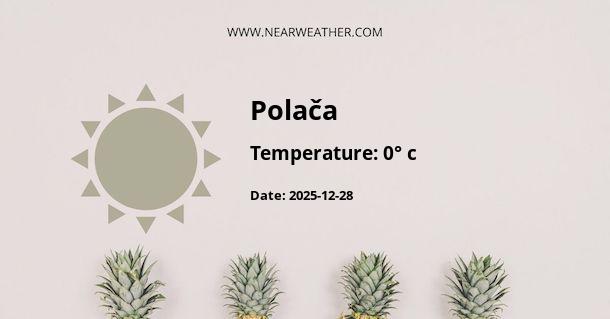Understanding Polača, Croatia's Climate and Weather Patterns
Located in the charming region of Dalmatia, Polača is a small municipality within Croatia. This region boasts a Mediterranean climate, influenced by its proximity to the Adriatic Sea. As a weather expert, when examining Polača's climate and weather, it's critical to analyze the data year-round to provide a comprehensive guide—fueled by research, local weather statistics, and climate models—that reflects the unique atmospheric conditions one can expect in this area.
General Climate Overview
In Polača, the climatic conditions are generally characterized by mild, wet winters and hot, dry summers—a pattern typical of the Mediterranean climate. The Köppen climate classification system places Polača in the Csa category, indicating these seasonal tendencies.
Seasonal Weather Patterns
Winter: December to February
- Average Temperatures: The winter months see average low temperatures ranging from 5°C to 6°C (41°F to 43°F) and high temperatures are typically around 12°C to 13°C (54°F to 55°F).
- Precipitation: This season experiences the most precipitation. Monthly averages can fluctuate significantly, but it's not unusual to observe up to 120mm of rain in the wettest months.
- Expert Opinion: "Winter rainfall contributes significantly to the lush landscapes one can enjoy in the Dalmatian hinterland," notes local meteorologist Dr. Ivica Vilibić.
Spring: March to May
- Average Temperatures: Moving into spring, the temperatures gradually rise, with average lows of 8°C to 13°C (46°F to 55°F) and highs of 16°C to 23°C (61°F to 73°F).
- Precipitation: Rainfall decreases as the season progresses, leading to more prolonged sunny periods.
- Expert Opinion: "Spring is characterized by a pleasant climate with a significant increase in sunshine hours," Dr. Vilibić adds.
Summer: June to August
- Average Temperatures: During summer, temperatures can soar, with average lows of 17°C to 19°C (63°F to 66°F) and highs often exceeding 30°C (86°F).
- Precipitation: This season is the driest, with some months recording less than 30mm of rainfall.
- Expert Opinion: "The Adriatic coast, including Polača, is known for its clear skies in summer, ideal for tourism," observes Dr. Vilibić.
Fall: September to November
- Average Temperatures: The temperatures during fall range from lows of 9°C to 16°C (48°F to 61°F) to highs of 20°C to 27°C (68°F to 81°F).
- Precipitation: Similar to winter, these months mark the transition back to wetter conditions, especially in November.
- Expert Opinion: "Autumn can sometimes bring about abrupt weather changes, as the depleted land heats up and interacts with the cooler sea," notes Dr. Vilibić.
Monthly Climate Averages
For a distinct view of the monthly climate variations in Polača, the following table compiles the average temperatures and precipitation levels based on historical data:
| Month | Average High (°C) | Average Low (°C) | Precipitation (mm) |
|---|---|---|---|
| January | 12 | 5 | 89 |
| February | 13 | 6 | 76 |
| March | 16 | 8 | 80 |
| April | 19 | 11 | 72 |
| May | 23 | 14 | 62 |
| June | 27 | 17 | 44 |
| July | 30 | 19 | 26 |
| August | 30 | 19 | 42 |
| September | 27 | 16 | 90 |
| October | 23 | 13 | 96 |
| November | 18 | 9 | 110 |
| December | 14 | 6 | 120 |
Unique Weather Events and Considerations
The weather in Polača is not without its unique characteristics. For example, the region is sometimes affected by strong, cold northeasterly winds known as the 'Bura.' These winds can cause sudden drops in temperature and can be quite intense, particularly during the winter months.
"The Bura winds are a significant weather phenomenon in Dalmatia, requiring careful monitoring and forecasting. They can influence everything from transportation to agriculture," explains Dr. Vilibić.
Another local weather occurrence is the 'Jugo' or 'Sirocco,' a warm and moist southeasterly wind often associated with stormy weather, which can primarily be observed in the autumn and spring months.
Annual Weather Summary and Projections
Analyzing the annual weather patterns, Polača enjoys approximately 2700 sunlight hours per year, making it one of the sunniest areas along the Adriatic cost. The average yearly temperature is about 16°C (61°F), while the average annual precipitation sits at around 900mm. When it comes to long-term projections, climate change remains a pressing concern, with potential implications for the intensity and frequency of weather events, as well as sea-level rise that can impact coastal regions.
"With the current climate trends, we could see a shift in Polača's traditional weather patterns, perhaps leading to hotter summers and even drier conditions," cautions Dr. Vilibić.
Travel Considerations Based on Climate
For those looking to visit Polača, each season offers something different. The best time for beach-goers and sun worshippers would be the summer months. Conversely, spring and fall provide comfortable weather for outdoor activities and exploration. Winters are mild compared to other European destinations, thus still making it a viable option for those looking to avoid the tourist crowds.
Conclusion
Overall, Polača's climate is representative of the Mediterranean idyll—warm, dry summers, and mild, rainy winters, all influenced by the beautiful Adriatic Sea. Whether planning a trip, engaging in seasonal activities, or studying climate patterns, understanding the subtle nuances of Polača's climate and weather is essential. Although forecasting and projections are subject to change, the data provided gives a strong foundational understanding of the region.
A - Polača's Latitude is 44.018330 & Longitude is 15.517500.
A - Weather in Polača is 14° today.
A - Climate Conditions in Polača shows scattered clouds today.
A - Humidity in Polača is 82% today.
A - Wind speed in Polača is 7.42 km/h, flowing at 160° wind direction. today.
